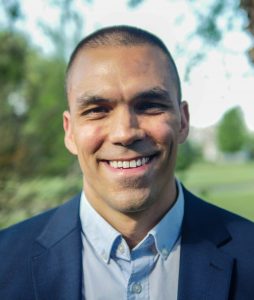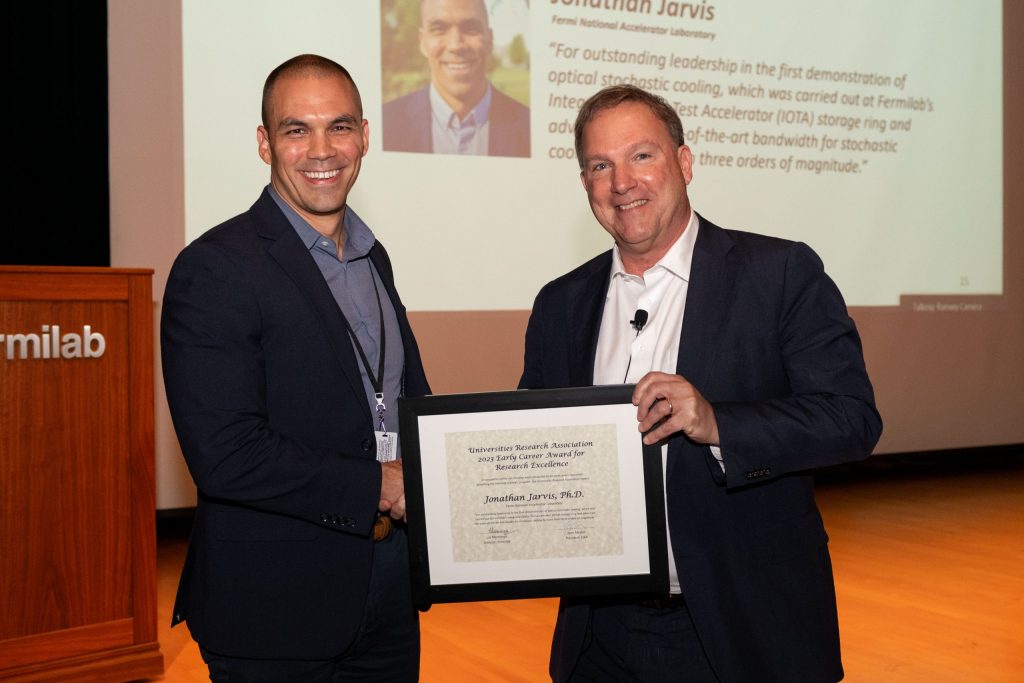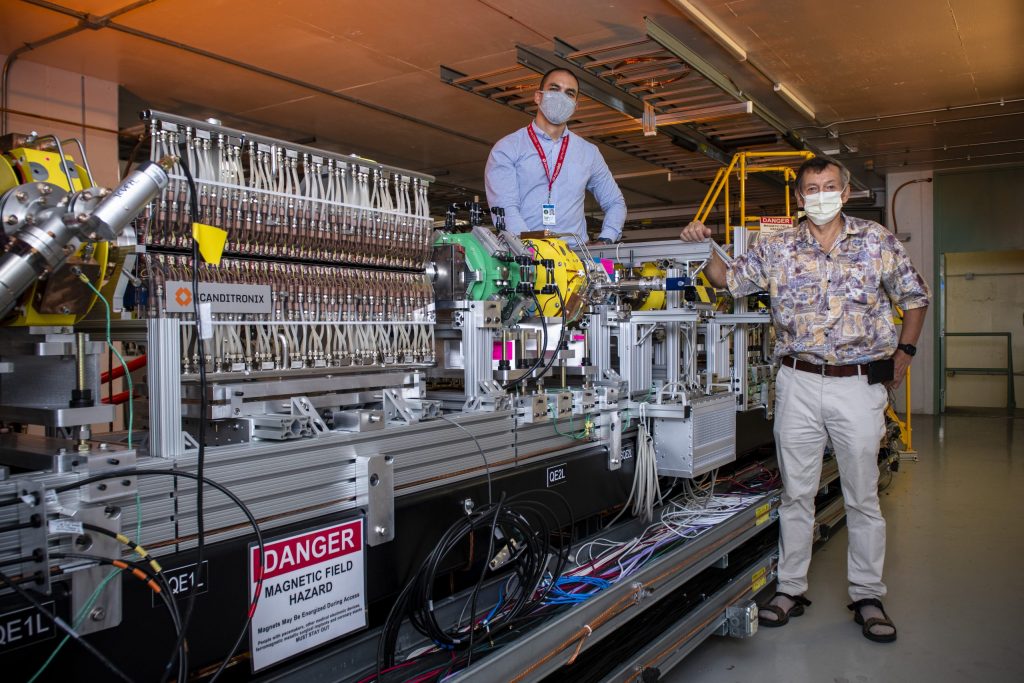
Jonathan Jarvis won the 2023 URA Early Career Award for his work experimentally demonstrating optical stochastic cooling. Photo: Jonathan Jarvis
Accelerator science is simply smashing. And new technologies, like those developed at the U.S. Department of Energy’s Fermi National Accelerator Laboratory, continue to push the frontier of collision experiments. A team led by physicist Jonathan Jarvis in the lab’s Accelerator Research Department has created a toolbox for this next generation of particle accelerators and storage rings. One vital component: technology to make particle beams dense enough to ensure an abundance of particle collisions.
The density of a particle beam is largely tied to how “cold” it is. “Particles in a beam have some momentum going in directions that diverge from the ideal direction,” said Jarvis. It makes the beam “fluffy” he explained, “which makes it less likely that particles will collide when you’re running collision experiments.”
Jarvis received the 2023 Early Career Award from the Universities Research Association in recognition of his work developing a functional optical stochastic cooling system, a new technology able to rapidly cool a diffuse beam into a dense beam. The annual award recognizes a Fermilab researcher at the beginning of their career who’s contributed outstanding work to the community.
“It is important to recognize remarkable scientists like Jonathan Jarvis who co-led experiments, such as the Optical Stochastic Cooling Experiment, which could help potentially increase the beam cooling rates at particle accelerators by up to four orders of magnitude,” said John Mester, president of the University Research Association.
“Jonathan also embodies the Fermilab spirit of fostering the next generation of scientists through his leadership and involvement with early career programs across the lab.”
How optical stochastic cooling works
If you imagine something being cooled, you may envision icy drinks on a hot day or a dip in a cold pond – placing a hot object in close contact with a cold object will eventually equalize their temperatures, cooling the hotter thing. But ice cubes and cold dips don’t cut it in particle accelerators.
Instead, stochastic cooling takes a more direct approach. Rather than cooling the beam by combining it with something colder, researchers use a detector to take a snapshot of the particles within the beam and then nudge each particle’s momentum toward an ideal using magnets, lenses and other optics. “What you want to do is basically remove disorder from the beam,” Jarvis said.

Jonathan Jarvis (left) received his award from URA President John Mester (right) at the ceremony on June 29. Photo: Ryan Postel, Fermilab
It’s similar to geese slowly converging into a V while migrating. When the flock first scatters into the air, the group may be going in the same overall direction, but each individual bird follows a slightly different trajectory. Some may veer up or down, others left or right, and still others fly slightly faster or slower than their compatriots. But eventually, each individual settles into the ideal formation, and the flock flies south as densely packed as comfortably possible.
Particles, however, cannot correct their own momentum to perfectly match their beam partners. So, the researchers help the particles out. “We send the beam through a device called a pick-up, which measures structural information about the beam,” Jarvis explained, “And then we use that structural information to correct the differences in momentum for each particle.”
The pick-up essentially takes snapshots of narrow slices of the beam, and the precision of those snapshots depends on the wavelength of the light that’s used – the shorter the wavelength, the thinner the slice. Conventional pick-ups use microwaves — the same radiation that’s in a microwave oven — with centimeter-long wavelengths. The individual snapshots contain millions or billions of particles, said Jarvis, which makes it impossible to measure a single particle’s momentum with a single snapshot. “All I can really see is the average of a million particles,” he said.
So Jarvis, and other researchers using stochastic cooling, send the beam repeatedly through the pick-up. With each pass, the average momentum of all the particles in the beam is tweaked toward the ideal value, but individual particles can still veer off course. It takes many thousands of passes to get each particle to cooperate and create a bright, dense beam.
It was this technology that won its inventor, Simon van der Meer, the 1984 Nobel Prize in Physics and enabled the discovery of the W and Z bosons in the CERN Super Proton Synchrotron collider.
Speeding up cooling
In the mid-1990s, researchers proposed a way to make stochastic cooling faster: change the light used to detect the particles.
The time it takes to cool a beam is proportional to the wavelength used in the pick-up because this wavelength determines how many particles are captured in each beam snapshot. Using near-infrared or visible light with wavelengths 1,000 times shorter than microwaves would capture a much narrower snapshot of the beam containing far fewer particles. With fewer particles in each snapshot, they could be nudged more precisely, cooling the beam more efficiently.
“Our big innovation was actually demonstrating optical stochastic cooling experimentally for the first time,” Jarvis said. His team published their results in 2022 in the prestigious journal Nature, nearly 30 years after it was first theorized. Their demonstration carried out at Fermilab’s IOTA storage ring, was a rousing success. “You had this beautiful Nobel Prize-winning technique in stochastic cooling,” Jarvis said, “and we managed to advance its fundamental mechanism by a factor of 1,000.”
Now, the team is working on amplifying the signal collected from the pick-up and sending it back into the beam as an even more powerful correction.

Jonathan Jarvis (left) and Valeri Lebedev (right) stand next to the experimental accelerator ring where they first demonstrated optical stochastic cooling. Photo: Ryan Postel
Jarvis explained that this is the perfect example of the kind of experiment his team usually runs. “We’re building the toolkit for the accelerator designers and operators of tomorrow,” he said, adding that they can also expand, or “heat,” the beam with this technique.
“We can envision plug-and-play versions of this technology for certain systems that lets you freely tune the beam structure,” Jarvis said. This can mean anything from creating pulses in the beam to having sections with complicated structure.
“We’re looking to benefit not just high-energy physics, but the whole accelerator research ecosystem,” he said.
It’s the kind of work that URA committee chair Laura Fields of the University of Notre Dame considers both valuable and often overlooked. “Accelerator science is a field that’s extremely critical to almost all of the science that’s done at Fermilab,” she said, “But it’s often not appreciated as much as it should be.”
Not only did Jarvis impress the committee with his scientific contributions, so did his extensive outreach at Fermilab, Fields pointed out. Jarvis leads an undergraduate research group and summer internship program, and is part of multiple working groups, she said.
“The work that Jonathan is doing is going to impact a huge number of scientists in the future at Fermilab and around the world,” Fields said, “We wanted to recognize that.”
Fermi National Accelerator Laboratory is supported by the Office of Science of the U.S. Department of Energy. The Office of Science is the single largest supporter of basic research in the physical sciences in the United States and is working to address some of the most pressing challenges of our time. For more information, please visit science.energy.gov.



